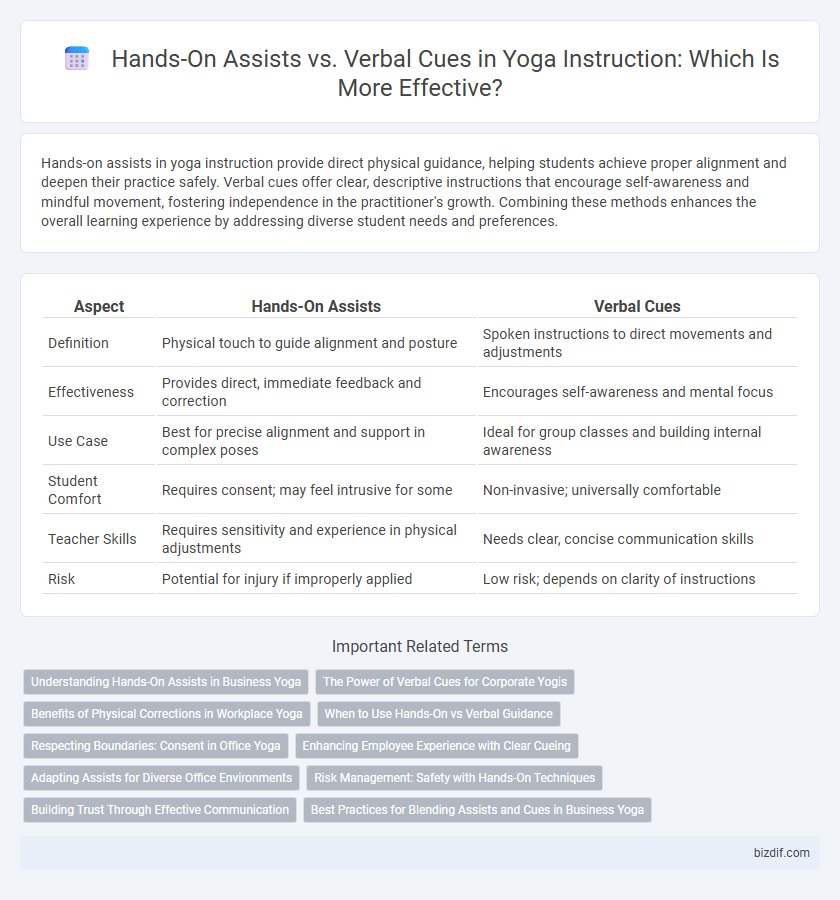Hands-on assists in yoga instruction provide direct physical guidance, helping students achieve proper alignment and deepen their practice safely. Verbal cues offer clear, descriptive instructions that encourage self-awareness and mindful movement, fostering independence in the practitioner's growth. Combining these methods enhances the overall learning experience by addressing diverse student needs and preferences.
Table of Comparison
| Aspect | Hands-On Assists | Verbal Cues |
|---|---|---|
| Definition | Physical touch to guide alignment and posture | Spoken instructions to direct movements and adjustments |
| Effectiveness | Provides direct, immediate feedback and correction | Encourages self-awareness and mental focus |
| Use Case | Best for precise alignment and support in complex poses | Ideal for group classes and building internal awareness |
| Student Comfort | Requires consent; may feel intrusive for some | Non-invasive; universally comfortable |
| Teacher Skills | Requires sensitivity and experience in physical adjustments | Needs clear, concise communication skills |
| Risk | Potential for injury if improperly applied | Low risk; depends on clarity of instructions |
Understanding Hands-On Assists in Business Yoga
Hands-on assists in business yoga enhance alignment and deepen student experience by providing tangible guidance that verbal cues alone may not convey. Effective hands-on adjustments require clear communication and consent to maintain trust and professionalism while fostering student growth. Integrating hands-on assists strategically supports personalized instruction, improving client retention and satisfaction in yoga businesses.
The Power of Verbal Cues for Corporate Yogis
Verbal cues enhance corporate yoga by providing clear, precise instructions that accommodate varying skill levels and office environments. Unlike hands-on assists, verbal guidance respects personal space, promotes mindfulness, and encourages self-awareness, crucial for professionals managing stress and posture. Effective verbal cues improve focus, alignment, and relaxation, making yoga accessible and adaptable in corporate settings.
Benefits of Physical Corrections in Workplace Yoga
Hands-on assists in workplace yoga provide precise alignment adjustments that enhance practitioners' safety and effectiveness, reducing the risk of injury during poses. Physical corrections enable instructors to address subtle postural misalignments that verbal cues alone may not convey, fostering deeper body awareness and improved technique. These tactile interventions promote immediate feedback, accelerating progress and creating a more personalized and supportive yoga experience in professional environments.
When to Use Hands-On vs Verbal Guidance
Hands-on assists are most effective during complex postures where precise alignment is crucial, or when students struggle to understand verbal instructions alone. Verbal cues work best in group settings, facilitating clear communication and respecting personal boundaries without physical contact. Prioritizing hands-on guidance in private sessions enhances personalized correction, while verbal guidance supports broader accessibility and student comfort.
Respecting Boundaries: Consent in Office Yoga
Hands-on assists in office yoga require explicit consent to respect personal boundaries and ensure participant comfort and safety. Verbal cues provide a non-invasive way to guide practitioners through poses without physical contact, accommodating those who prefer autonomy or have sensitivity concerns. Prioritizing clear communication about consent fosters a respectful environment that supports both effective instruction and individual well-being.
Enhancing Employee Experience with Clear Cueing
Hands-on assists in yoga instruction provide personalized adjustments that deepen alignment and foster trust, enhancing the overall employee experience. Clear verbal cues improve comprehension and safety by guiding practitioners through precise movements and breath awareness. Combining both methods optimizes learning, engagement, and injury prevention in workplace wellness programs.
Adapting Assists for Diverse Office Environments
Hands-on assists in yoga instruction provide personalized alignment adjustments that enhance practitioner safety and posture accuracy, especially in diverse office environments with varying space constraints. Verbal cues offer flexible guidance adaptable to remote or hybrid work settings where physical contact may be limited or inappropriate. Tailoring assists--both hands-on and verbal--according to office ergonomics, cultural considerations, and employee comfort fosters inclusive and effective yoga sessions.
Risk Management: Safety with Hands-On Techniques
Hands-on assists in yoga instruction offer precise alignment corrections but carry inherent risks such as discomfort or injury if not applied with consent and proper training. Verbal cues provide a safer alternative by guiding students through mindful adjustments without physical contact, reducing liability concerns. Prioritizing clear communication and obtaining explicit permission ensures safety while maximizing instructional effectiveness.
Building Trust Through Effective Communication
Hands-on assists in yoga instruction create a tangible connection that fosters trust by providing personalized guidance and physical support. Verbal cues enhance clarity and mindfulness, helping students understand alignment and intention while respecting their comfort zones. Combining both methods cultivates a safe and supportive environment, essential for deepening student confidence and engagement.
Best Practices for Blending Assists and Cues in Business Yoga
Effective yoga instruction in a business setting combines precise hands-on assists with clear verbal cues to enhance participant alignment and safety. Prioritizing consent and clear communication ensures that physical adjustments support individual comfort levels while verbal guidance reinforces correct posture and breath control. Integrating these techniques fosters a balanced, inclusive atmosphere that maximizes the benefits of workplace yoga programs.
Hands-on assists vs Verbal cues Infographic

 bizdif.com
bizdif.com